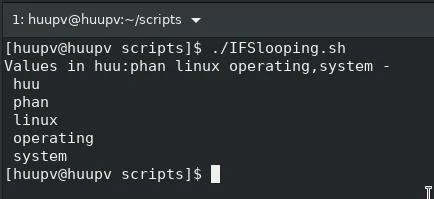How to bash script use IFS in context of for looping
Introduction
Learn how to effectively use IFS (Internal Field Separator) in Bash scripts, particularly within for loops. This comprehensive guide covers basic to advanced examples to enhance your scripting skills.
In Bash scripting, mastering the Internal Field Separator (IFS) is key to handling strings and data processing effectively. The IFS variable allows you to control how the shell interprets and splits strings into words, which is particularly useful when iterating over data with for loops. This article explores the meaning and application of IFS in Bash, focusing on its use in for loops with practical examples.
What is IFS in Bash?
What Does IFS Mean?
IFS stands for Internal Field Separator. It is a special shell variable used to determine how Bash splits a string into words. By default, IFS includes space, tab, and newline characters, but you can customize it to suit your needs.
Why is IFS Important?
Understanding and using IFS allows you to handle and process strings more flexibly in your scripts. It is especially useful when dealing with file contents, user input, or any other form of structured data.
Using IFS in For Loops
Basic Example
Here's a basic example of using IFS in a for loop:
#!/bin/bash
# Author: HuuPV
IFSOLD=$IFS
IFS=$'\n':,' '
for entry in "huu:phan linux operating,system"
do
echo "Values in $entry -"
for value in $entry
do
echo " $value"
done
done
IFS=$IFSOLD
Explanation
IFSOLD=$IFS: Save the original IFS value to restore it later.IFS=$'\n':,' ': Set IFS to newline, colon, and comma to split the string accordingly.- The outer for loop iterates over the string "huulinux operating,system".
- The inner for loop splits each
entryinto individual values based on the IFS setting. IFS=$IFSOLD: Restore the original IFS value.
Output
When running the script, the output will be:
Values in huu:phan linux operating,system -
huu
phan
linux
operating
system
Advanced Examples
Reading a File Line by Line
IFS can be particularly useful when reading a file line by line. Here's an example:
#!/bin/bash
filename="example.txt"
IFS=$'\n'
for line in $(cat $filename); do
echo "$line"
done
Processing CSV Files
IFS is invaluable when dealing with CSV files. Consider the following example:
#!/bin/bash
filename="data.csv"
IFS=','
while read -r col1 col2 col3; do
echo "Column 1: $col1, Column 2: $col2, Column 3: $col3"
done < "$filename"
Nested Loops with Custom IFS
You can also use custom IFS settings in nested loops. Here's an advanced example:
#!/bin/bash
data="row1:val1,val2;row2:val3,val4"
outerIFS=$';'
innerIFS=$','
for row in $data; do
IFS=$outerIFS
echo "Processing $row"
for val in $row; do
IFS=$innerIFS
echo "Value: $val"
done
done
Common Pitfalls and Best Practices
Resetting IFS
Always reset IFS to its default value after modifying it to avoid unexpected behavior in other parts of your script:
IFS=','
# Your code
IFS=$' \t\n'
Quoting Variables
When using IFS, it's essential to quote your variables to prevent word splitting issues:
IFS=','
for item in "$string"; do
echo "$item"
done
Combining IFS with Read
Using read with IFS can help you parse complex data structures:
data="name:John,age:30,city:New York"
IFS=','
for entry in $data; do
IFS=':'
read -r key value <<< "$entry"
echo "$key is $value"
done
FAQs
What is IFS in Bash?
IFS stands for Internal Field Separator, a special variable that defines the characters used to split strings into words.
How do I change the IFS value?
You can change the IFS value by assigning a new string to it, e.g., IFS=','.
Why should I reset IFS after use?
Resetting IFS prevents unintended behavior in other parts of your script that rely on the default word splitting characters.
Can I use IFS with other commands?
Yes, IFS can be used with various commands like read, cut, and awk to control data parsing.
Conclusion
Understanding and using IFS in Bash scripts, especially within for loops, can significantly enhance your scripting capabilities. By mastering IFS, you can create more flexible and robust scripts that handle data more efficiently. Practice with the examples provided, and soon you'll be adept at using IFS in any scripting scenario.
This comprehensive guide has covered the basics and advanced usage of IFS, including practical examples and best practices. With this knowledge, you're well-equipped to tackle more complex scripting tasks in Bash. Thank you for reading the huuphan.com page!

Comments
Post a Comment